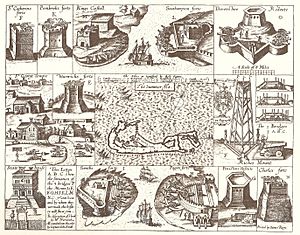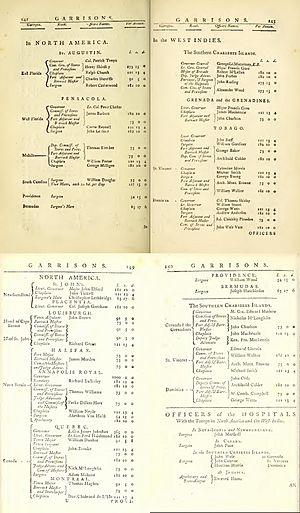Bermuda Garrison facts for kids
Quick facts for kids Bermuda Garrison |
|
|---|---|
| Bermuda | |

Presentation of Colours at Prospect Camp
|
|
|
Location in Bermuda
|
|
| Coordinates | 32°17′58″N 64°45′55″W / 32.2994949°N 64.7653454°W |
| Type | Barracks |
| Site information | |
| Owner | Ministry of Defence |
| Operator | |
| Site history | |
| Built | 1793 |
| Built for | War Office |
| In use | 1793 - 1957 |
The Bermuda Garrison was the military group that protected the British island of Bermuda for many years. It included soldiers from the regular British Army and local volunteer forces. This garrison existed from 1701 until 1957.
Bermuda was very important to the British Empire. It served as a main base for the Royal Navy in the North Atlantic. The garrison's job was to defend the island, especially the Royal Naval Dockyard. This dockyard was a key place for repairing and supplying British warships.
Over time, the garrison grew and changed. It started with a small group of soldiers and later included many different types of forces, like artillery and infantry. After 1957, the regular British soldiers left. However, two local part-time groups, the Bermuda Militia Artillery and the Bermuda Volunteer Rifle Corps, continued. They later joined together to form the modern Royal Bermuda Regiment.
Contents
- Early Defenses: 1609 to 1701
- First Regular Soldiers: 1701 to 1768
- Bermuda's Growing Importance: 1793 to 1815
- The 19th Century: A Growing Garrison
- First World War: 1914-1918
- Between the Wars: 1918-1939
- Second World War: 1939-1945
- The End of the Garrison: 1945 to 1957
- After 1957: The Royal Bermuda Regiment
- Military Establishment of Bermuda
- Images for kids
Early Defenses: 1609 to 1701
Bermuda was first settled by the English in 1609. This happened by accident when a ship called the Sea Venture crashed there. For many years, Bermuda's defense was handled entirely by its own local citizen-soldiers, called militias.
During the English Civil War, Bermuda supported the King. The island's defenses were very strong. They had coastal forts and a well-trained militia. This made it too difficult for Parliament's forces to capture the island in 1651.
Bermuda's forts were some of the first stone fortifications built by the English in the New World. They are still standing today. These forts, along with St. George's town, are now a UNESCO World Heritage Site. Besides the militia, there were also full-time artillerymen. They operated the cannons in the forts.
First Regular Soldiers: 1701 to 1768
In 1701, the English government sent a small group of regular soldiers to Bermuda. This was because of the threat of war. This group was called an Independent Company.
Even with these professional soldiers, the local militia remained Bermuda's main defense. After a major war ended in 1763, the Independent Company was removed. By 1768, only the local militia was left to defend the island.
Bermuda's Growing Importance: 1793 to 1815
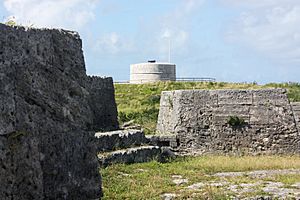
After the American colonies became independent in 1783, Britain lost its naval bases in North America. This made Bermuda much more important as a naval base. The British Admiralty (the government department in charge of the navy) began buying land in Bermuda to build a large dockyard.
The Royal Naval Dockyard started being built in 1795. This was a huge project. At the same time, the British Army sent soldiers back to Bermuda in 1793. This was because of the French Revolution and the wars that followed.
The main army camp was set up at St. George's Garrison. Bermuda was called an Imperial Fortress. This meant it was a key military base. Its purpose was to defend the naval base and to be a starting point for military operations against the United States if needed.
Bermuda's Role in the War of 1812
During the War of 1812 between Britain and the United States, forces based in Bermuda attacked the American coast. In 1813, a military leader named Sir Thomas Sydney Beckwith came to Bermuda. He commanded a force that raided the American coast, especially around Chesapeake Bay.
In 1814, a much larger force of 2,500 soldiers arrived in Bermuda. They sailed from Bermuda to join other British forces. This led to important events like the Burning of Washington and the Battle of Baltimore. These attacks were in response to American actions in Canada.
After these wars, the local militias in Bermuda became less active. The British Army garrison took over most of the defense duties.
The 19th Century: A Growing Garrison
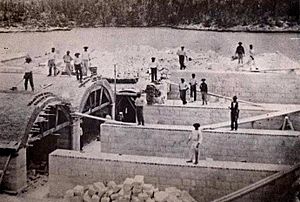
After the wars with France and the United States ended, Britain reduced its army size. However, Bermuda's importance to the British Empire kept growing. Many forts and artillery batteries were built to protect the island. These were manned by the Royal Artillery.
The Royal Engineers were also very important. They built new forts, improved old ones, and created roads and other facilities. They even built a causeway connecting St. George's Island to the main island.
The Royal Army Ordnance Corps had a depot at Ordnance Island. This is where they stored ammunition for the coastal artillery. A secret underground gunpowder store was also built on Agar's Island in 1870.
Most soldiers were first stationed around St. George's. But as the City of Hamilton grew and the Dockyard developed, the army also moved westward. A large camp called Prospect Camp was built in the center of Bermuda around 1855. This camp housed infantry troops.
Another camp, Warwick Camp, was added mainly for rifle ranges. This allowed soldiers to practice shooting safely. Other smaller army sites included Watford Island and Boaz Island, near the Dockyard.
Local Forces Return
In 1892, the British government wanted Bermuda to help pay for its own defense. They encouraged the local government to create part-time military units. The Bermudian parliament finally agreed. They created the Bermuda Militia Artillery and the Bermuda Volunteer Rifle Corps. These units would support the regular British soldiers.
The reason Bermuda agreed was linked to tourism. The British government would not allow American investment in a new hotel or the widening of a shipping channel unless Bermuda contributed to its own defense. This showed how important Bermuda was as a military base.
From then on, the plan was to reduce the number of regular soldiers. More of the defense duties would be taken on by the part-time local units. For the rest of the 19th century, military personnel made up a quarter of Bermuda's population. Defense spending was the most important part of Bermuda's economy.
First World War: 1914-1918
When World War I began in 1914, the local Bermuda Militia Artillery (BMA) and Bermuda Volunteer Rifle Corps (BVRC) were ready for war. Many Bermudians also joined other British Army units overseas.
The BMA sent two groups of volunteers to the Western Front in France. They helped with ammunition supply and served in important battles like Vimy Ridge and Ypres. The BVRC also sent a group of soldiers to the Western Front. They joined the Lincolnshire Regiment and fought bravely.
Canadian battalions also served in Bermuda during the war. They replaced British regular soldiers who were sent to fight in Europe. These Canadian units trained in Bermuda before deploying to the front lines.
Between the Wars: 1918-1939
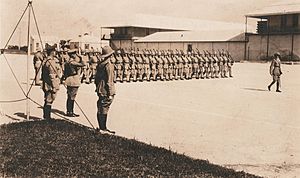
After the First World War, the number of regular British Army soldiers in Bermuda was greatly reduced. Most of their roles were given to the local part-time units. In 1928, the regular artillery and engineer units were withdrawn. Their jobs were taken over by the BMA and a new unit, the Bermuda Volunteer Engineers (BVE), formed in 1931.
Most of the old coastal forts were closed. Only St. David's Battery remained active. It watched over the main shipping channel. A new unit, the Bermuda Militia Infantry, was created in 1939. This unit helped with infantry duties, especially at the West End of the island.
Second World War: 1939-1945


During World War II, the local units were again called up for full-time service. Conscription (requiring people to join the military) was introduced for British males living in Bermuda. The regular British Army company managed the main headquarters at Prospect Camp. They also patrolled the central parts of the island.
The BVRC defended the East End of Bermuda, and the BMI defended the West End. They guarded important places like the Dockyard and trans-Atlantic cable facilities. The BMA operated the guns at St. David's Battery and a new battery at Warwick Camp. The BVE operated searchlights for the artillery and handled all communications for the garrison.
Bermuda also hosted Canadian Army units during the war. These included the Winnipeg Grenadiers and the Pictou Highlanders. The island became a key base for air and naval forces. The US military also built airfields and bases in Bermuda starting in 1941.
The End of the Garrison: 1945 to 1957
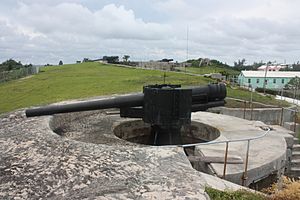
After World War II, some local units like the BVE and BMI were disbanded. The BMA and BVRC were reduced in size but later rebuilt. Conscription was brought back for these two units, but for part-time service.
The last coastal artillery, the Examination Battery at St. David's Head, was closed in 1953. The BMA then changed its role to infantry.
In 1951, it was announced that the Royal Naval Dockyard would close. By 1953, the regular British Army garrison was also withdrawn. However, a small group of soldiers from the Royal Welch Fusiliers was brought in for a special meeting in 1953. This meeting included Prime Minister Winston Churchill and US President Dwight D. Eisenhower.
After this meeting, a company of the Duke of Cornwall's Light Infantry arrived in 1954 to continue garrison duty. But in 1957, the decision was made to finally withdraw all regular British soldiers from Bermuda. This was due to the British Army's smaller size and the high cost of keeping soldiers in Bermuda. The local part-time units were seen as capable of taking over.
After 1957: The Royal Bermuda Regiment
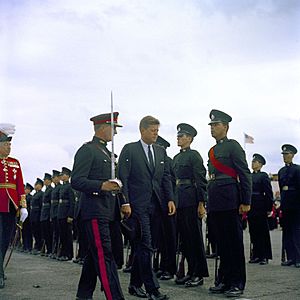
Since 1957, no regular British Army units have been permanently stationed in Bermuda. However, small groups of soldiers have visited for training or ceremonial events.
In 1965, the two remaining local units, the BMA and the BVRC, combined to form the Royal Bermuda Regiment. This new regiment trains for different roles. These include helping the police with public safety and providing relief after hurricanes. They also perform ceremonial duties that were once done by the professional soldiers. The Royal Bermuda Regiment often helps other British territories in the Caribbean after natural disasters.
Military Establishment of Bermuda
- North America Command
- Nova Scotia Command
- St. George's Garrison (Eastern District Headquarters)
- Ordnance Island
- Royal Army Service Corps Wharf (St. George's)
- St. George's Armoury
- East Coast Forts (St. George's, Paget, Governor's, and St. David's Islands)
- Fort St. Catherine's
- Fort Victoria
- Fort Albert
- Western Redoubt
- Fort George
- Town Cut Battery (or Gates' Fort)
- Alexandra Battery
- Fort Cunningham
- Fort Popple
- Paget Fort
- Smith's Fort
- Peniston's Redoubt
- St. David's Battery
- Castle Islands Fortifications
- Devonshire Redoubt
- Landward Fort
- Queen's Castle (King's Castle, The Castle, Seaward Fort)
- Southampton Fort
- Martello Tower
- Burnt Point Fort
- Ferry Island Fort
- Prospect Camp (Command Headquarters and Central District Headquarters)
- Warwick Camp
- Agar's Island
- Royal Army Service Corps Wharf (Hamilton)
- Hamilton Armoury
- Prospect Hill Position
- Fort Prospect
- Fort Langton
- Fort Hamilton
- South Shore Batteries (former fixed batteries adapted for field guns)
- Fort Bruere
- Bailey's Bay Battery (Tucker's Town Battery, and Tucker's Town Bay Fort)
- Newton's Bay Fort (Hall's Bay Fort)
- Albouy's Fort
- Harris' Bay Fort
- Sears' Fort
- Devonshire Bay Fort
- Hungry Bay Fort
- Crow Lane Fort (also known as New Paget's Fort and East Elbow Bay Fort)
- Middleton's Bay Fort (also known as Centre Bay Fort)
- West Elbow Bay Fort
- Warwick Camp Battery
- Warwick Fort
- Jobson's Cove Fort
- Great Turtle Bay Battery
- Jobson's Fort
- Hunt's Fort (Lighthouse Fort)
- Ingham's Fort
- Church Bay Fort East
- Church Bay Fort West
- Boaz Island and Watford Island (Clarence Barracks; Western District Headquarters)
- Somerset Armoury
- Whale Bay Battery (West Whale Bay)
- Whale Bay Fort (West Whale Bay)
- West Side Fort
- Wreck Hill Fort
- Scaur Hill Fort
- Daniel's Island Fort
- Mangrove Bay Fort
- King's Point Redoubt
- Maria's Hill Fort
- St. George's Garrison (Eastern District Headquarters)
- Bermuda Militia. 1612–1815.
- Bermudian Militia, Volunteer and Territorial Army Units, 1895–1965
- Bermuda Militia Artillery
- Bermuda Volunteer Rifle Corps
- Bermuda Volunteer Engineers
- Bermuda Militia Infantry
- Royal Bermuda Regiment
- Bermuda Home Guard
- Bermuda Cadet Corps
Images for kids
-
Ordnance Island (left) and St. George's Town from Barrack Hill in 1857.
-
1877 gravestone of Sergeant John Matthias Bevan, ASC, in the new cemetery of St. George's Garrison.
-
1st Battalion, 19th Regiment of Foot Warrant Officers and Non-Commissioned Officers in Bermuda around 1879-1880.
-
Royal Navy and British Army Church Parade at the Cathedral in Hamilton, around 1900.
-
Officers of the 3rd Battalion, The Royal Fusiliers, in Bermuda in 1905.
-
War Department Ordnance Survey Marker, Bermuda.
-
St. David's Battery (or the Examination Battery), St. David's, Bermuda in 2011.



